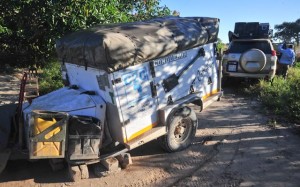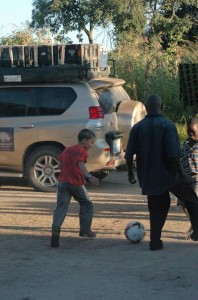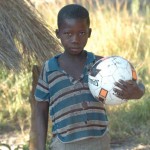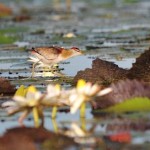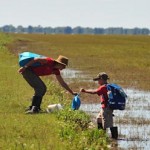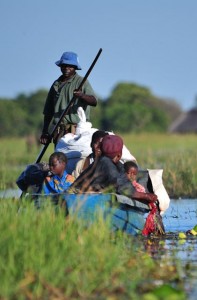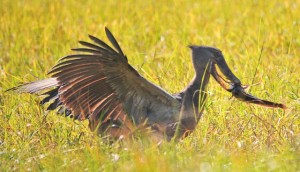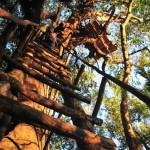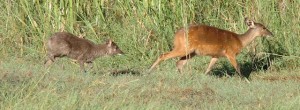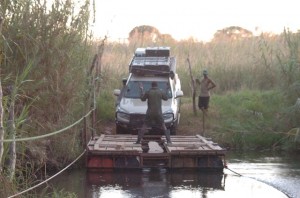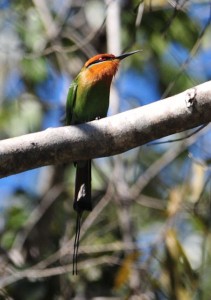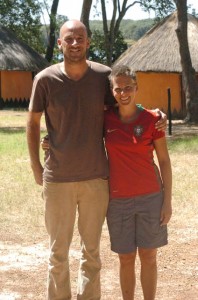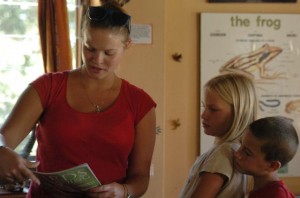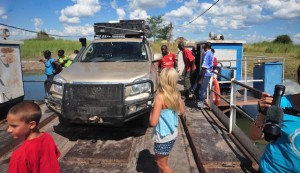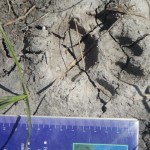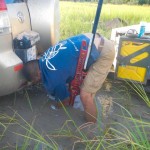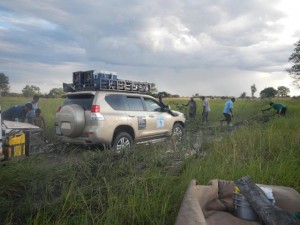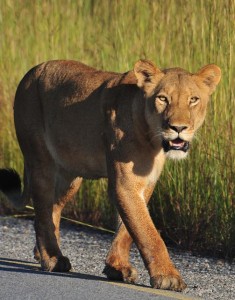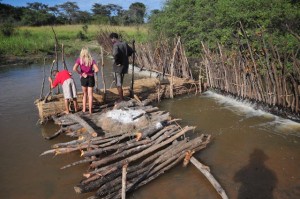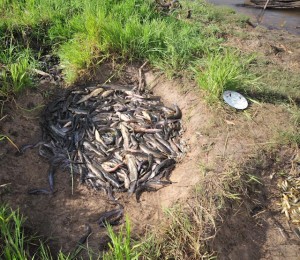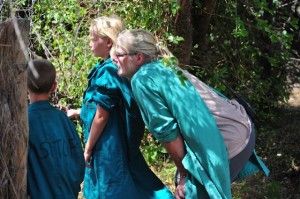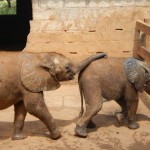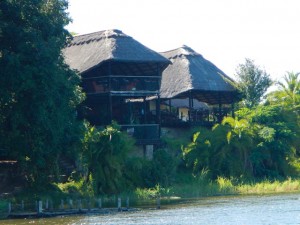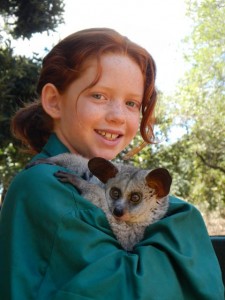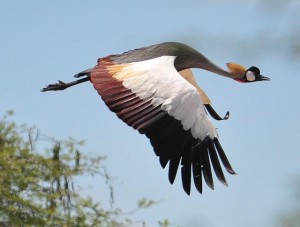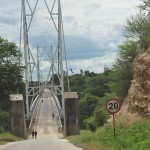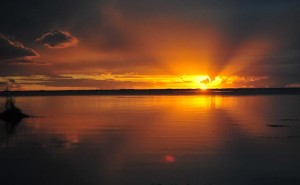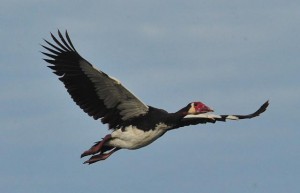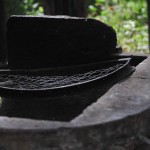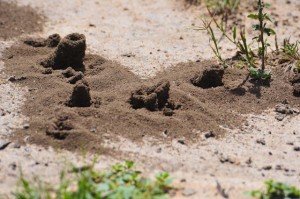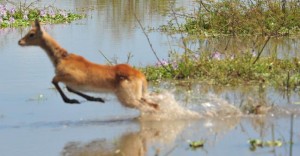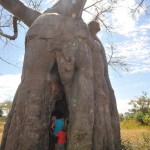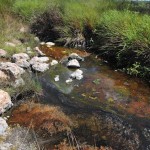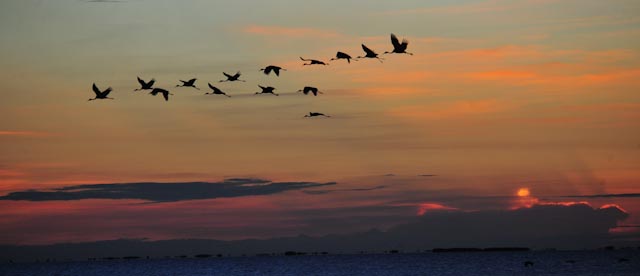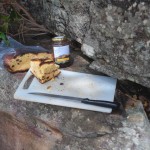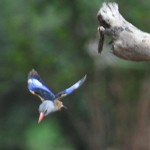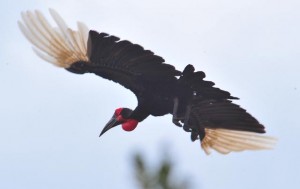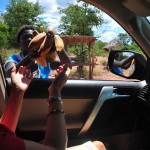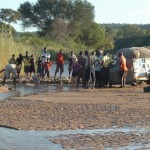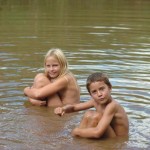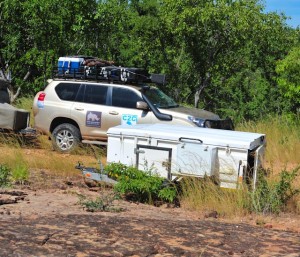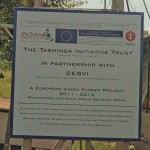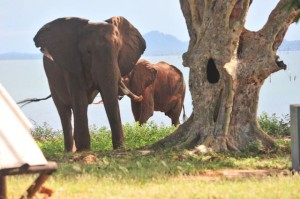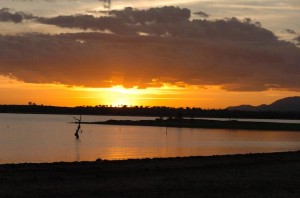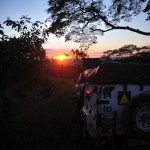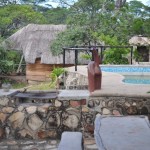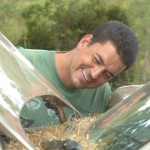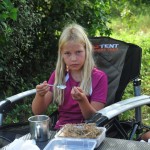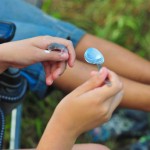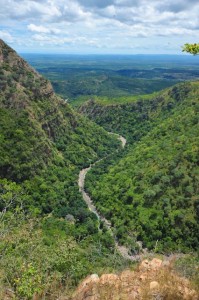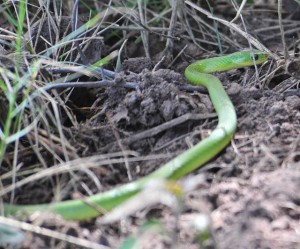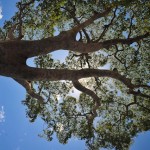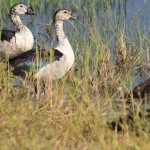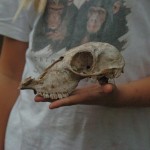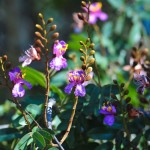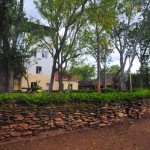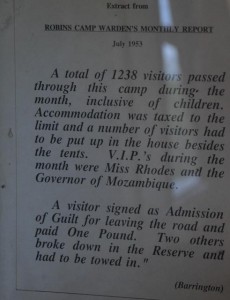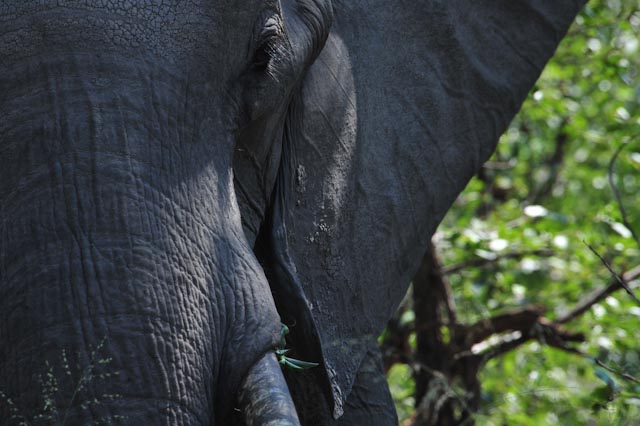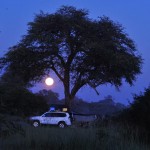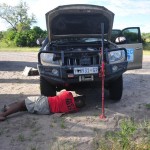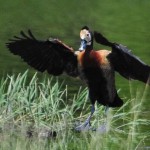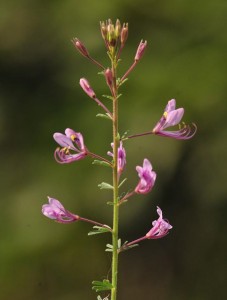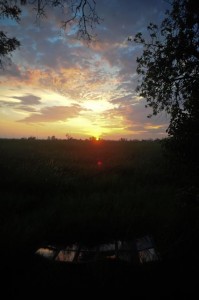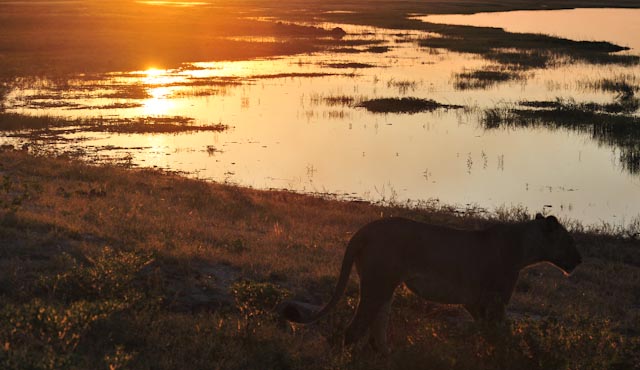Cape to Cairo Journey:
Pages to Explore:
Blog Catagories:
Photo of the day








Home | About Us | Safaris & Photographic Trips | Blog | Contact Us | Sitemap | Disclaimer
The Essence of the Journey!
We would like to do this trip to experience new cultures.
We would like to understand what makes African people pure.
What are their spiritual beliefs, understandings?
How does the spiritual world we know exist to them?
What can we learn from them?

┬ĀBenguelu Swamps – Shoebills
Bumping and bouncing as we travelled village corridors towards the Benguelu swamps.┬Ā To find the shoebill, perhaps the most sought of birds on any birders list.┬Ā The rear view mirror showed a disturbing sight, the trailer was sagging.┬Ā Perhaps I could limp to Chikuni, 13kms away.┬Ā The axle was cracked on one side, there was nowhere to stop and repair her.┬Ā Pretty soon it was evident that Chikuni ┬ĀScout Camp was a bridge too far.
As darkness fell, we emptied the last of the diesel from our jerry cans into the vehicle, this in an effort to reduce what weight we could from the trailer.┬Ā 100m, and the trailer was hanging even lower, impossible to go further.┬Ā This left us stranded and could be potentially terminal.┬Ā We pulled in to Mr MansonŌĆÖs place, a 39 year old Zambian national, with 6 children.┬Ā We were the focus of attention as you can imagine. ┬ĀA smiling face, brilliant white teeth, Mr Manson greeted me as I came around the car to see what our options were.┬Ā ŌĆ£You can stay here, he offeredŌĆØ.┬Ā I gave him 60 pin, some chicken and lamb sausages, we were welcomed around the fire with his family.┬Ā Earlier I had mentioned to the children in Lochinvar that in Africa, no fire is owned, it is there to be shared.┬Ā This was just such an example.
I was really tired.┬Ā Mentally, physically tired.┬Ā We had been on the road from Kasanka to Benguelu for 10 hours, averaging 12km an hour.┬Ā The road was really crappy, and used more by pedestrians and bicycles, full of potholes, bad ones.┬Ā As well as this, there were hordes of children, screaming out ŌĆ£Hello Bwana ŌĆō sweets ŌĆ” ŌĆ£.┬Ā There is a never-ending tug-of-war of wanting to help everyone, and itŌĆÖs just not possible.┬Ā I found that this really had a draining effect on my energy levels and emotions.┬Ā When we were travelling dead slow, there was a group that formed of about 30 children that followed the vehicle.┬Ā They were touching the vehicle, and one even pulled the plastic cover that guards the spare wheel bolt right off the back of the vehicle.┬Ā I did not know at the time, however gone forever.┬Ā Was this the end of our trip?┬Ā Would the trailer be written off?
After some cheese sandwiches, we chatted briefly around the fire with Mr MansonŌĆÖs family.┬Ā There was a young lady of 15 that was breast feeding a child of about 6 months.┬Ā She was full of comments, giggles and smiles.┬Ā In fact there were 8 young ladies huddled around the focal point (fire), giggling and chatting away in Bemba – no English.┬Ā Each seemed to have an opinion.┬Ā After about 30 minutes, we said our good nights and retreated to the car, which would be our bed for the night.┬Ā With towels as pillows, windows slightly opened, the night had the sounds of mozzies and hippos, juxtaposed.
The mother was the first one up in the morning.┬Ā She had her thatch brush, and in her familiar bent over position, she forced the dust away, leaving the hardened mud behind, an improved surface.┬Ā From about 05h30, there was a dull, timely thud that started up.┬Ā One at first, but within 15 minutes there were 5 others, ladies grinding the cassava into a fine powder that would be their main meal of the day, porridge.┬Ā I had to make some decisions, put some plans in place.┬Ā I suggested to Nicolai to pull out his football and play with the other boys, there was a 7 year old, and a younger 5 year old up and staring at us.┬Ā Nicolai was shy, and so I got the ball and started the process off by kicking the ball back and forth to Mr Manson.┬Ā Nicolai joined in and then the other boys.┬Ā The international language was at work again.┬Ā Within minutes there were smiles, laughter and joy.┬Ā Shoes made up goal posts and two teams made up.┬Ā In a makeshift yard about 30m2, there was one goal, victory.┬Ā
I moved the Staffie out the way and Celeste and I went about taking items out the trailer, transferring them to the car and packing them on the roof rack.┬Ā I had decided that we would leave the trailer with┬ĀMr Manson┬Āand push on to Shoebill Island Camp.┬Ā We had booked two days there, and I would then consider our options.┬Ā The trailer was insured,┬Ā considering that the axle was the core of the trailer, perhaps she’d be written off?┬Ā This would mean putting a claim in, the cost of getting the ŌĆśwreckŌĆÖ back to civilization would be prohibitive.┬Ā In the mean time we had spent so much time and effort getting to Benguelu, we had to give ourselves the reward of searching for the elusive shoebill.
We waved a cheerful goodbye to Mr Manson and confirmed that we would see him in a few days, returning with a plan and a way forward.┬Ā ŌĆ£No problemŌĆØ he assured us.
The rest of the way was as┬Āawkward as what we had been through.┬Ā
I idled along in a somber mood, with the extra load of six more ammo boxes on the roof, I moved forward cautiously, aware of the additional load and strain on Staffie.┬Ā We arrived at the muddy floodplain to a marvelous reception of a few thousand Black Lechwe, Wattled Cranes and other birds ŌĆō everywhere.┬Ā
As we arrived, there was a waving group leaving the plain ŌĆō recent visitors to Shoebill Camp.┬Ā Once youŌĆÖve chosen your track you are set.┬Ā You cannot steer off it.┬Ā We were greeted by Padson, Emmanuel and another.┬Ā I left a solar panel on, powering the freezer left on in the car.┬Ā A watchman would be appointed ŌĆō 50 pin ŌĆō ŌĆ£ŌĆ” these fishermenŌĆØ.
After a 45 minute mokoro trip from Chikuni, we arrived at Shoebill camp.┬Ā We were treated to a neat setup with canvas tents, bathrooms en suite.┬Ā Everything is flat, so there is no gravity feed and without power, no pressure pumps either.┬Ā Water for ablutions is manually fed.┬Ā Although we brought our own food, there is a cook or and waiter that service the dining room and guests.┬Ā What a treat.┬Ā
We decided to take it easy the rest of the day, having not slept well in the car, we took an afternoon nap, followed by a walk around the camp.┬Ā There are resident Brown Firefinches, HartlaubŌĆÖs Babblers and Woodland Kingfishers.┬Ā Hippos are around and the evenings bring the calls of the Swamp Nightjar, Spotted Eagle Owl and Spotted Hyena.┬Ā The fishermen have their say too ŌĆō beating drums herd off the elephant.
David Phiri is the camp manager, and he was unfortunately suffering from Malaria.┬Ā He had no muti and I promised to get some for him from the vehicle the next day.┬Ā We set off for our four hour Shoebill excursion in search of said bird.┬Ā 1 hour ŌĆō nothing – 1h30 ŌĆō nothing still.┬Ā Then more in hope I asked about a grey form in the distance.┬Ā With Padson and Emmanuel as paddlers and 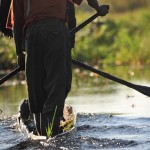 Shoebill looking outers, they crouched down suddenly ŌĆō shoebill they confirmed.
Shoebill looking outers, they crouched down suddenly ŌĆō shoebill they confirmed.
Slowly we edged forward.┬Ā I took some quick snaps in case the shadow flew off.┬Ā We moved closer and closer.┬Ā Mr ShoebillŌĆÖs focus seemed to be otherwise.┬Ā He was looking sideways at a movement in the reeds.┬Ā In a flash he seized a Barbel, large at about 30 cm and maybe 2 kilograms.┬Ā This allowed us to get up fairly close, as he tried, and tried, and tried to swallow the fish whole.┬Ā The Barbel is notorious for itŌĆÖs hard skull and ability for living out the water, and was proving a menace of a meal.┬Ā The ShoebillŌĆÖs bill is designed to crush the skull of any fish, and obligatorily this was done.┬Ā
Fascinating minutes were spent, enjoying the spectacle of this half stork half pelican having a meal.┬Ā ŌĆ£Thank you Mr ShoebillŌĆØ we said as we reversed backwards, into the swamp, without disturbance to Mr Whale beak.
The news came through, Dave had arranged for a truck to collect the trailer and it would be taken to Chinaponde where the┬Āchassis would be welded.┬Ā So I set off with David, Emmanuel and Padson to the trailer.┬Ā After a 45 minute mokoro trip to the car, we got into Staffie and travelled a further
90 minutes to where the trailer was parked.┬Ā We had left at 12h00, with the expectation that we would rendezvous with the truck around 14h00.┬Ā This was DavidŌĆÖs (whose reputation precedes him as a superlative bush mechanic) first look at the trailer.┬Ā He immediately jumped into action, as a sergeant commanding his troops would.┬Ā Jack, 4 pound, lift.┬Ā He tried lining up the axle, inspecting the damage thoroughly, tobacco rolled with newspaper, one eye half shut.ŌĆØWe can fix this,ŌĆØ he said.
Well, with no sign of the truck, we set about lifting, knocking, shoving the axles so that they lined up.┬Ā The ideas was to leave the trailer jacked up with rocks, wooden planks, return to camp, then make a trip in the morning with materials so that we could bolt the┬Āchassis and be able to tow the vehicle out to where there would be power so as to weld the┬Āchassis and complete the repairs.┬Ā This was because David did not have much confidence of the truck arriving or any other back-up help.┬Ā Well, after 4 hours of shifting and shoving the trailer and her chassis and axles were in place.┬Ā Ten minutes later, the truck arrived.
The truck was not a monster, it was probably a 1989 model Mitsubishi Canter.┬Ā This meant undoing the alignment and work that had been done.┬Ā In the fading light, we positioned the truck between the winch and the trailer.┬Ā The winch then pulled the trailer towards the truck, whilst 16 men grappled on a hold, lifting the trailer onto the loadbed.┬Ā The trailer only just fit onto the truck, with one of the dropsides down.┬Ā The decision was whether it was now worth taking the trailer (which hardly fitted on the truck) to Mpika 200km away, when the road was in such awful condition.┬Ā One bad pothole and lapse of concentration, and the trailer could bounce off the loadbed.┬Ā Besides scratching, scraping and breaking the trailer, this was a serious risk to the driver and passengers too.┬Ā I must say that this was my feeling all along, but with the trailer now visibly on the truck, David agreed.┬Ā Offload the trailer.┬Ā The truck got stuck in the maneuvering process and Staffie winched her out.┬Ā WeŌĆÖd have to come back tomorrow and try the original plan.┬Ā 12v drill through angle iron, jack and bolt.┬Ā At least there was a planŌĆ”
By: Celeste
Climbing the wooden ladder had me a bit breathless, not with exertion, but with nervous energy ŌĆō okay, and a bit of vertigo. ŌĆ£There, there, a sitatunga!ŌĆØ we whispered in hushed excitement, the early morning sun catching the reddish brown mammal
emerging from the thicket into a grassy clearing ŌĆō magnificent ŌĆō gone. A black-backed barbet perched momentarily on a dead branch just metres from us at eye level so high up in the Machan Sitatunga Hide. A pair of crowned eagles perched for longer, silhouetted.┬Ā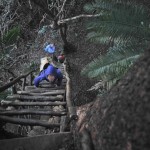
Kasanka was initiated as a National Park by two private individuals in1972 and is managed by Kasanka Trust. It is only 420 square kms in area but sports a variety of vegetation zones from dry evergreen forests to moist forest and permanent papyrus swamps. It lies in the southern fringes of the Benguelu Swamps and is only about 30 km from the DRC border. The high rainfall and flat, low-lying
terrain results in an extensive marshy area ŌĆō Kapabi Swamp ŌĆō as well as numerous dambos: shallow, waterlogged grassy depressions (i.e. a vlei). These are rich in grasses, herbs and flowering plants for grazing. The major vegetation type is miombo woodland with tall brachystegia trees and underlying grasses. Birding is challenging, to say the least with long periods of quiet until a bird party comes through. Patience.
Along the rivers there are giant trees with an interlocking canopy. The favourite, of course, is the Red mahogany (Khaya nyasica). One specimen near the Fibwe guard post ensures the best look-out ever from its 18m ŌĆślevitatingŌĆÖ platform. The views at sunrise and sunset bring the light in swathes through the swishing papyrus far below.
At our campsite near the pontoon we were surrounded by such beauty and peace, tall red mahoganies with an opening in the thick papyrus, overlooking the swamp and the Kasanka River. In the early morning mist, like a fairytale creature, materialise the shy sitatungas to feed in family groups. In the backround are the spur-winged geese, herons and white-backed ducks. On the move overhead there is a small troop of Blue monkeys, just the shake of branches giving their presence away.
A bush shower in a reed enclosure was welcome ŌĆō even hot water warmed over the fire and transferred into the overhead bucket was delivered by the two helpers ŌĆō smiling and willing. ŌĆ£Hop in quickly before it gets cold. YouŌĆÖve got two minutes.ŌĆØ Wet, lather, rinse, dry and apply poison ŌĆō mozzies, mozzies everywhere.
These two men were also the pontoon ŌĆśpullers and pushersŌĆÖ who did an excellent job with the heavy Prado. In order to cross into the western part of the park, one has to braveŌĆ”drum rollŌĆ” The Pontoon. It is mostly safe with only one (Park) vehicle having succumbed to the river in its history. On one of our crossings it was a bit touch-and-go, swaying and tilting alarmingly to the left. Put it all down to good video footage. At least the relief on landing is genuinely heartfelt, accompanied by much clapping and ululation!
Although the Shoebill has reportedly been sighted in the vicinity, we were not so lucky. Searches for Pels, walking in the Katwe area in the Bufumu Forest were fruitless. On the Chikufwe Plain we had to re-trace our tracks as the aerodrome area was waterlogged ŌĆō and not even a FullebornŌĆÖs Longclaw for our efforts. From the Luwombwa Lodge we went on a morning boat excursion with Friday ŌĆō it also just happened to be a Friday. Still no Pels but plenty of kingfishers and bee-eaters, especially BoehmŌĆÖs. The Luwambwa River was fast-flowing and the children had an interesting time steering the boat ŌĆō a bit like the rest of our trip I guess. Colourful dragonflies enjoyed the ride as we snaked through the thick Waterberry trees (Syzygium 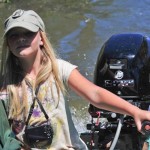 cordatum). Hot and sunburnt, Nicolai leant over to dip his hat in, the strong pull tugging it from his grasp. ŌĆ£Hat overboard!ŌĆØ yielded a quick turnabout. A pair of Giant kingfishers displaying on low, overhanging branches was a fitting end.
cordatum). Hot and sunburnt, Nicolai leant over to dip his hat in, the strong pull tugging it from his grasp. ŌĆ£Hat overboard!ŌĆØ yielded a quick turnabout. A pair of Giant kingfishers displaying on low, overhanging branches was a fitting end.
Frank, a Dutch ecologist, and his wife have been at the main Wasa Lodge for four years, simple chalets overlooking the Wasa Lake, with resident Goliath heron standing guard. He (Frank, not the heron, or maybe the heron too) is so delighted with the area that he plans to stay on indefinitely. One can sense his enthusiasm, his positivity evident in his sparkling eyes, Swarovski binoculars a permanent fixture around his neck. A group of 11 American students and their professors were due for a two week visit and he was excited by the prospect of sharing his knowledge with them. Interrupting our chat, he had to supply a weapon to a staff member who had apprehended a poacher.
Near the entrance to the Park, just outside itŌĆÖs borders so the locals do not have to pay Park entrance fees, is a great information centre. Skulls, displays and posters are clean and up-to-date, thanks to the three lovely ladies who are in charge: one local, an American Peace Corp volunteer and a British teacher, busy with a biology class right there.
Fascinating plaster-of-Paris footprints of puku, lechwe, sitatunga, water and banded mongoose, blue duiker. Well done for a fantastic effort.
We were sorry to have missed the highlight of Kasanka: the five million straw-coloured bat migration occurring in November-January, the biggest migration of its kind in the world. Next time. Never say neverŌĆ”
At sunset, loud crashing far below turned out to be a hippopotamus rushing riverwards, disappearing within a minute into the swamp. The chill of the wind and darkness sent us homewards, tentwards. Maybe a root extract from the Tassel berry (Antidesma venosum) with its proven physiological effect on the heart would be in order. How does one cure the heartache for and of Africa?
Kafue National Park – Zambia
ŌĆ£You can go on any road in Kafue National ParkŌĆØ
It was April and there were no more rains.┬Ā This was somewhat liberating, considering that there was much consternation and deliberation as to which was the best route to take into and around Kafue.┬Ā Kafue is really large, in fact at 22 400 km2 it is about the size of Wales.┬Ā The roads in Wales you can drive on easily, so can you in Kafue, apparently.┬Ā Having spent the night at Itezhi-Tezhi we ventured through the Musa gate.┬Ā We spent the evening at the New Kalala camp where we met Lawrence and his wife (fantastic farming folk from Lusaka).┬Ā
ŌĆ£Can I get to Nanzhila for lunch?ŌĆØ I semi-joked with the ZAWA official at the gate.
ŌĆ£Easily she repliedŌĆØ.┬Ā It was 09h00.
So, full of the new, first-hand information, we set out for Nanzhila, ŌĆśeasily arriving for lunchŌĆÖ.┬Ā Having time on our side, and the fact that all roads were doable, we opted for the more scenic river road.┬Ā Well, going was slow.┬Ā There was tall, grass, lots of it (mostly Hyparrhenia hirtha) and there was a fair amount of sandy ridges. ┬ĀIt was great to see a small herd of 5 Sable.┬Ā By 15h00, we had not reached Nanzhila for lunch; we were however about 5km away as the crow flies.┬Ā We had hit a few wet patches, but nothing that Staffie, could not get through.┬Ā OK, there was one place we had to winch
ourselves through.┬Ā This dambo (flooded grassy swamp with sticky black cotton soil) was different though.┬Ā Celeste kindly walked through the beginning section, unfortunately not the last 2/3rds of it.┬Ā With vigour and momentum I attacked said dambo.┬Ā Half way through, and we ground to a halt.┬Ā Thigh deep in places (waist deep for Nicolai) we were in trouble.┬Ā With 250m left to exit the dambo, the winch could not reach any trees or notable supports.┬Ā What to do now?
Driving slow roads is draining, but grinding to a halt, miles from help, takes that wind from you. ┬Ā┬ĀWithin a few minutes though, you realize that you have to solve the problem yourself, so get on with it.┬Ā Bury the spare wheel in the swamp and try winch out from there?┬Ā
We had noticed some lion prints (great samples) embedded in the clayey soil just prior to entering the swamp.┬Ā We waded through water to where there were some fallen trees and started collecting and breaking off, bits of trees.┬Ā The plan was that we would hi-lift the wheels of the vehicle, jabbing branches under each of the wheels, and then drive out ŌĆō easy.┬Ā I pulled Cel out of earshot from the kids and whispered ŌĆ£ ŌĆ” we may be here overnight, so prepare yourself, this may take a while.ŌĆØ
With some more solid matter under each wheel, we gave it a go.┬Ā The wheels ground and
mushed and turned freely, not this time.┬Ā The light was fading – it was past 5pm.┬Ā
What a surprise to see approaching figures, Oliver and his 3 sons.┬Ā Local fishermen. ┬ĀWe were stuck, as if I needed to tell them.┬Ā Oliver had worked at Nanzhila, and confirmed that the lodge was not far, but smiled and shook his head, almost in disbelief that we had come so far on the road, ŌĆ£you cannot use this road for another 2 monthsŌĆØ he said.┬Ā ŌĆ£But the ZAWA officer said that it was passable,ŌĆØ I contested with a smile.┬Ā Knowing full well that this was no longer the issue, but rather the 3,5 tons stuck in the swamp.
Kafue opens up itŌĆÖs borders to local fishermen for one month of the year and allow them to fish extensively within the park during this time.┬Ā This really sounded positive to me and was a way of keeping the community involved and interested in conservation of the park.┬Ā There were other initiatives in the park too, this seemed like a good one.┬Ā Oliver offered to help, and immediately his 3 sons disappeared.┬Ā They could not speak English, unlike the benefit Oliver had received as a result of his employment at the lodge.
The returning fishermen brought with them young Mopane tree branches, and with the shovel proceeded to force them under each wheel.┬Ā With the trailer now unhitched from the vehicle, I expectantly got into the driver seat.┬Ā Rock forward, back, forward quickly ŌĆō no joy.┬Ā Two wheels in particular were misbehaving badly.┬Ā The sun was now gone.┬Ā Fiery Necked Nightjars were now calling and we could hear a hyena calling in the distance.
With the shovel not getting deep enough, we started to jack each wheel up and again inserting fresh branches.┬Ā The rear right jacking point gave way.┬Ā With a ŌĆśkonkŌĆÖ in the body work, the nut disappeared into the bog.┬Ā ŌĆ£ItŌĆÖs 4×4.┬Ā 3 wheels propped and stacked will be enoughŌĆØ I said assuringly.┬Ā In truth not knowing, but their faces grew more sullen as their hopes seemed to disappear into the swamp with said bolt.┬Ā We were now shadows, and the waxing moon had not been of assistance.┬Ā I had to try to raise my spirits; hopefully the othersŌĆÖ would follow.┬Ā Sloshing into the front seat, I realized this was probably the last chance for the evening.┬Ā Having tried unsuccessfully on 2nd start, I was now in tank mode.┬Ā Low range, diffs engaged, slowly I pressed the accelerator.┬Ā The wheels were loose, then a little bit of traction, then slipping, then some traction.┬Ā ŌĆ£Whoa, whoa ŌĆ” ŌĆ£ or something similar was the shout.┬Ā I glanced in my rear view mirror, the back right wheel was slipping badly.┬Ā Austen, the one son that was pushing from the back right was getting pasted in mud, as the wheel turned spastically amongst the black muck and freshly cut mopane.┬Ā The opinion was clearly to stop.┬Ā Not a ŌĆśdonderŌĆÖ, this was it – get free or sleep in the swamp.┬Ā Accelerator to the floor, the shouts were louder.┬Ā Like teeth sinking into a hot newly bought gum guard, the Goodrichs bit and let go, bumping and bouncing, with cheering bodies crouched in the mud behind me, I got to the other side. ┬Ā┬Ā┬Ā
With the help of our newly met local friends, I snaked my way through young trees around
the swamp back to the start point.┬Ā With the winch round the trailer, her nose was lifted out the mud as we pulled her slowly free.┬Ā Oliver got a lift back with us to a scoutŌĆÖs camp 7 km back, with his near rotten drying fish on our trailer nose cover – a smell that, to this day, follows us despite several washes to the cover.┬Ā I was so happy with the effort and passion and each fisherman received 50 000 Kwacha reward.┬Ā This was well received and the following morning Oliver gave us a tour of his fishing camp and their traditional fishing methods.┬Ā This was fascinating to say the least.┬Ā
The fishermen block off the river flow (typically 75 or so metres wide) with trees.┬Ā They leave a small gap, about half a metre wide and 3m in length. Into the gap, the water rushes through, as do the fish, which fall into a weaved basket type weir, unable to escape.┬Ā They average about 200 fish/hour in the evenings.┬Ā I was told there are about 14 such ŌĆśtrapsŌĆÖ along the river, which are dismantled at the end of the season.┬Ā It was disheartening to see that even the smallest fish are taken, but a relief that it is only for 30 days.
The David Shepherd foundation has been synonymous with Kafue, and with David now 81, having given his life to the reserve.┬Ā The elephant sanctuary has been running the last four years and Liz took us on a thorough tour, explaining that only elephants that can be self-sustaining in the future are assisted.┬Ā Generally the youngsters are rescued when their mothers are shot by poachers, which continues to be a major problem in Southern Africa.┬Ā They currently have a facility in Lusaka
for young that are less than 3 years and still on formula and the more adolescent ones are kept at the Kafue facility.┬Ā Each visitor wears a green overcoat so that bright colours are associated with other, less friendly people.┬Ā Over the past few months they have received an elephant a month.┬Ā They rely heavily on donations and are providing an outstanding service.
The northern section of Kafue is where Jacques and Linda van Heerden run Mukambi Lodge.┬Ā Two folk that are so comfortable in their own skin.┬Ā Smiling, happy, run a smooth operation type of folk.┬Ā Staff are happy, and even Basil the hippo finds the vibes so good that he plonks himself down on their reception area.┬Ā We were treated to the Villa for a night, on the Kafue river, with all the luxuries.┬Ā We met the Swanepoels at Mukambe too.┬Ā It seems lekker people just stick together.┬Ā
In spite having a grass net, the grass seeds had filled the radiator.┬Ā We travelled back to
Lusaka slowly, 80km/h and less than 2000 rpm.┬Ā Dan Wyllie helped us big time.┬Ā The best mechanic I have ever met, and really a top bloke too.┬Ā Absolutely thorough.┬Ā Robyn his wife runs the back office, and Anna and Faye are two of the dearest young girls you could meet.┬Ā Thank you Dan for your donation of time and skill, professionalism and hospitality.┬Ā It is a privilege to know you guys.
Oh yes, and Celeste cracked the windscreen smashing a tsetse fly ŌĆ”
Making the Crossing: From Zimbabwe to Zambia
by ┬ĀCeleste
Every kilometre is further from South Africa, home, familiarity. Zimbabwe had
been wonderful but cloyingly sad. That said, moving northwards into Zambia was fraught with mixed emotions and tainted and probably faded memories of our previous travels here.
The border post was everything we had feared. A new, large one-stop at Chirundu, out the Zimbabwean side no hassle. Getting into Zambia was a different matter entirely. We had to get past a certain Mr. Somebody, planted largely out of his too small chair under him, with ego to match. He was the Interpol Man and would find something to say over us powerless mortals who dared into his ego space. We had to get another insurance letter for the vehicle, which after two hours had still not come through via email or fax, the joys of Zambwian networks.
Marcelo had gone elsewhere to conduct this business and the children and I stood in front of Mr. Somebody all that time and watched him play ŌĆśDiamond RushŌĆÖ on his cellular telephone ŌĆō very busy. Blah, blah, blah, boring border story but we were sure glad it was all over when somehow it sort of resolved and we were granted entrance into the Land of Oz, or something like it. Beautiful valleys and trees, lush and green with a good road led us into the ŌĆśEmerald CityŌĆÖ, Lusaka.
Here for car and trailer stuff and to re-stock, we were pleasantly
surprised at itŌĆÖs friendliness and safety. Eureka campsite is on a farm (gardens, pool, impala, zebra, a reindeer, nightjars, owls and even bushbabies) and is just within the southern boundaries of the City. We achieved all we set out to do here within record time: tyre checks, shock absorber replacements for the trailer at Ironman; foreign exchange, malaria muti (Coartem) (in case), laundry, groceries, new slip-slops for the kids (AGAIN!), great breakfast and coffee all at a new centre just 6kms up the road, Makeni Mall.
Up, up and awayŌĆ”.
Lochinvar National Park
It is hard to believe that Lochinvar is a National Park or that it is designated as a ŌĆśWetland of International ImportanceŌĆÖ by the WWF. Not because of its lack of beauty or ability to instil wonder, but rather due to the tragedy, the farce and pretence of these labels. There is a blur between settlements and the boundaries and park use with about 15 gun-toting game scouts seemingly either having given up or in cahoots with the local activities. The story of people and wildlife pressure, human rights,
regulations and enforcements, access to raw materials, game, fish and ŌĆ”.. thoughts echo round and round in my mind.
ŌĆ£African skimmers! There, there, there!ŌĆØ I shout excitedly. Lifers. Moving swiftly and surely over the water of the Chunga Lagoon which reaches all the way to the horizon in the darkening sky. Amazing how they use their bills to catch fish, snapping them closed. Just imagine those mechanics. That was just the beginning of all the delights: crowned and crested cranes in their thousands; ducks; spur-winged geese; storks; ibises ŌĆō all day long, flying over us, in front of us, behind us ŌĆō a sheer spectacle of delight. A single pelican. A pair of fish eagles and pied kingfishers kept us entertained whilst our afternoon cricket game kept a single marabou stork entertained as he edged closer and closer. Ever had that feeling youŌĆÖre being watched?
Red Lechwe in the floodplain. Marcelo gets some great shots. I am fascinated by the history of the area. An old, dilapidated once farm house, once Lodge, now ruins, wide-eyed window holes staring vacantly over the plain, soured with gross graffiti. Drum rocks (Ibbwe Lyoombwa), considered sacred by the locals for their echo when tapped and used as a part of manhood rituals.
A baobab sporting a 2×2 m ŌĆścaveŌĆÖ, which was supposedly formed by a man with a magical club, according to the areaŌĆÖs Chief Hamusende. Beware all who enter without upholding the local customs or the entrance will seal up and close forever behind you. Sebanza Hill, occupied since the Iron-Age and a great look-out in times of turmoil, which were frequent between the fierce Tonga/ Ila tribes and the Batwa with hundreds of men being killed and their mass burial sites.
Gwisho Hot Springs with waters varying from about 60 ŌĆō 94 degrees C surrounded by lush vegetation, gorgeous African star-chestnut trees (Sterculia Africana) and Real fan palms (Hyphaene petersiana), salt encrusted rocks reddened with algae. Poor belly-up frogs ŌĆō the proverbial frogs in hot water, just like the two scorpions who came limping out the massive log we had burning for 24 hours already. Suddenly they decided to budge.
We were very quick to budge the morning the fishermen
and their boats arrived from far and wide, laden with 100s of kilograms of fish. Market day. Having no campsite, no facilities at all, we had camped right at the end of the road at the waterŌĆÖs edge, two pairs of hippoŌĆÖs eyes staring whilst we shut our eyes to the litter and focused on the vast waters and its abundant birdlife instead. Beauty is in the eye of the beholder ŌĆ”.
Mana Pools – Zimbabwe – Marcelo
The roads to Mana are good, very good by Zimbabwe National Park standards.┬Ā Coming from Matusadona and Chizarira they are superb.┬Ā We had arrived at the gate on Saturday evening at 19h00 and greeted the lady at the gate with a loud and exuberant ŌĆśHELLO, weŌĆÖd like to camp at Mana Pools pleaseŌĆÖ.┬Ā Being caught off guard, IŌĆÖm not sure by the volume or the friendliness, the lady as polite as could be asked for our permit.┬Ā Not having one was clearly not going to float the boat.
ŌĆ£You need to get one from Marondera officeŌĆØ she said
ŌĆ£But itŌĆÖs closed nowŌĆØ I guessed.
She must have thought I was a real toffee, but I found that it sometimes helped to state the obvious.┬Ā ŌĆ£Yes.┬Ā You will have to get one tomorrow morning at 07h00, when the office opensŌĆØ was the reply.
This meant going up the Zambezi escarpment, where we had just come from, find a place to camp and try again tomorrow.┬Ā In essence this was the right decision.┬Ā It was still another 80km or so to Nyamepi camp, and IŌĆÖm sure they would not allow driving at night.┬Ā So I thanked her and after chatting with two friendly, armed, anti-poaching guards at Marondera, we camped there the night.
The Zambezi Valley is a western extension of the Great Rift Valley, the huge geological fault that extends right down the continent of Africa.┬Ā The southern edge is formed by the Zimbabwean escarpment. The Zambian side, which you see as you descend, ┬Āmarks the northern edge of the Valley.┬Ā Mana Pools was declared a UNESCO World Heritage Site in 1984 and forms a Core Area of the Middle Zambezi Biosphere Reserve designated by UNESCO in 2011.
As you drive into the park, you notice how the changing mopane and dry ŌĆ£jesseŌĆØ forests
give way suddenly to woodlands of acacia, mahogany and other large trees nearer the river.┬Ā This change in vegetation marks the southern edge of the old river terraces ŌĆō the area over which the Zambezi has meandered and shifted its course over thousands of years.┬Ā The terraces are covered with fertile, alluvial soils deposited by the river during its meanderings.┬Ā The Pools of Mana, are ox-bow lakes which mark former courses of the Zambezi, which are refilled during the rains.
Nyamepi camp site is in an ideal setting despite itŌĆÖs failing infrastructure.┬Ā Last night we heard 2 lion prides close by, hyaena, and had elephant in the camp site, hippos and beautiful, old, tall, trees.┬Ā The place feels good on the mighty Zambezi, overlooking the rolling hills of Zambia.┬Ā We listened hard for Pels, but heard him not.
There are herds of impala, water buck, zebra aplenty.┬Ā Baboons and vervets are also common, perhaps too much so.┬Ā Elephant too are familiar.┬Ā There is no electricity, hot water courtesy of wood-lit boiler but the sites are on picturesque river bank settings.┬Ā The road was recently graded and widened.┬Ā This may be due to some EU sponsorship, being a world heritage site?
We had an afternoon rain shower which lasted close to an hour, and Lisa and her family were returning from an activity where they had hired a canoe, paddled up stream before the heavens opened.┬Ā Lisa came across and greeted us, effervescent and full of fun, in spite of being wet and cold.┬Ā The boys were looking to play, and so we were invited for some hot chocolate.┬Ā
It was dusk by the time we returned.┬Ā Nicolai had played some soccer against their 9 year old and lost 5-4.┬Ā Our Danish friends run an organic chocolate making business in Cape Town, where they had lived the last three and a half years, and they were returning to Denmark, but not before they had a 7 week sojourntravelling around southern Africa.
Around 17h30 we returned to our campsite and it was when I went to hang up one of our, now clean pot covers on the washing line that I felt a scratch, a hard, deep scratch on my left ankle.┬Ā I thrust my leg up to rid myself of this annoying piece of bush scratching me.┬Ā Well, I was startled to see a snake, somersaulting backwards off my leg, revealing itŌĆÖs pale white underbelly.┬Ā It must have been about 80cm long, thick but not ŌĆśpuffadderŌĆÖ thick.┬Ā The wheels started turning.┬Ā I had been bitten by this snake.┬Ā I had stood on it, not noticing it in the 20cm high grass/weed growing around the washing line.┬Ā No fault of the snake, it must have got an equal surprise, turned and grabbed a hold of the offender, me.┬Ā What was the snake?┬Ā I immediately tried to search, find some clues, but he was gone.┬Ā Clearly the cooling effect of the rain had caused him to move slowly, perhaps not as alert as he would normally be, allowing me to put my size 11s on his body.┬Ā What do I do now?
Not knowing the snake was a problem.┬Ā How long did I have to live?┬Ā It did not seem to be one of those harmless thin house ŌĆśsnakeyŌĆÖ types.┬Ā I moved over to break the news to the family.┬Ā Cel broke down.┬Ā It had been a trying few days with some tough roads, and this was too much.┬Ā Nicolai immediately howled in unison and Danica was still.┬Ā I said not to worry as it did not look serious.┬Ā
The alarmed snake clearly made a good effort of biting me, to be hurled through the air when I shook my leg, he must have had a hold of some of my leg.┬Ā There were 4 clear puncture marks on my left ankle, however, fortunately my bone got in the way, and prevented the bite going too deep.┬Ā Maybe the suddenness of the leg flick helped too?
Celeste said that the reason we had taken out emergency medical evacuation was because of this.┬Ā Ok, well if I had to start that process, get out Sat phone, look for a number to dial, charter a flight, blah blah, I guessed best case, 12 hours from Mana Pools to some help.┬Ā If it were Mamba, Adder or one of the serious snakes, it would be game over anyway.┬Ā I took the reptile book and tried to have a look, identify what type of venom I was dealing with: neurotoxic, cytotoxic or haemotoxic? How much time did I have?┬Ā Unfortunately, the book did not have pictures of snakes twisting through mid air, revealing their under-belly in the shadows of fully grown Kigelia Africana in failing light.┬Ā I was back into unknown territory.
ŌĆ£Is it sore Dad?ŌĆØ Nicolai wanted to know.
ŌĆ£IŌĆÖm fine my boyŌĆØ I assured him not really knowing the truth.
I put up a brave face, but Celeste was not buying it.
ŌĆ£What are you feelingŌĆØ she demanded.
ŌĆ£The bite is sore to the touch, sort of stinging.┬Ā Adrenalin is pumping, I do not know if itŌĆÖs as a result of the snake bite, or just a normal reaction that my body is giving to shockŌĆØ I told her.
This could be the end of the trip.┬Ā The end of me.┬Ā How did I feel about it?┬Ā A little surreal actually.┬Ā There was really very little I could do, if it was one of those hectically venomous snakes, this was it, game over.┬Ā Should I write a letter, maybe say things to Cel that IŌĆÖve always wanted to?┬Ā Mind you, I do often tell her I love her, and the kids.┬Ā There was really not much unfinished business.┬Ā However I did want to see them grow up, conquer the world, be by their side.┬Ā I had thought of a chat Nicolai and I had recently, about one of the Star War scenes where OB1Kanobi lets himself be slain by Darth Vader, and the question from Nicolai: why?┬Ā And so I had to try and explain the concept of immortality to a 7 year old.┬Ā Well perhaps I could take that approach, and influence their lives the way that OB1Kanobi did LukeŌĆÖs?
So I tried to act normal.┬Ā I was preparing a chicken pot for supper, but Cel assured me she was exhausted and did not want any supper, and rather go straight to bed.┬Ā So I revised the plans and went for a simpler pasta dish.┬Ā She didnŌĆÖt want me to open a beer and suggested that a Coke would have been better.┬Ā An hour and a half had passed, and my left leg was feeling pins and needlish like.┬Ā In fact it was a bit like a bee-sting, itchy, you know when it starts getting better and the skin feels tight and hot.┬Ā Hmmm, I asked her if we had brought any adrenalin with us?┬Ā This did not go down well.┬Ā She said no, but in more words.┬Ā We had 4 first aid kits, with lots of stuff, that importantly made her feel comfortable, but I did not really know what was in them.┬Ā I know from 1st aid courses I had done that one is supposed to lie still, and think happy thoughts.┬Ā The days of tourniquets and sucking out venom have passed, but quite frankly I did not want to lie still and act like a pancake, especially if they were my last few moments on earth.┬Ā I figured that the adrenalin would help if I started getting lethargic, or my heart stopped or something ŌĆō a la Pulp Fiction.
My calf got numb, and the lymph node in my left groin got really sore.┬Ā I had a few ŌĆścrampy spasmyŌĆÖ type sensations, but I woke up the next morning, with a smile on my face.┬Ā I was alive.┬Ā I thanked AA Raphael for the help.┬Ā It was 05h30, the Lions were calling, 2 prides, and the Ground Hornbills started calling time for some good strong coffeeŌĆ”
Matusadona National Park ŌĆō Zimbabwe
Celeste
┬ĀLeaving Chizarira, the road wound through interesting terrain, alternating flat and winding and climbing again through pretty villages. Schoolchildren were outside, collected like
leaves under large, shade trees; some in uniform, some not. Bicycles, usually with more than one person, the pedaller sweating heavily, the other clinging clumsily behind. Two pumpkins (one for free as a thank you) and ten small, fat finger bananas bought at a roadside stall. Two on a small scooter skidded to a halt on a sandy uphill and had to disembark. Fields of mielies and green, leafy vegetables ( rape) as if crossed between spinach and rocket, each atop its own mound of earth. We purchased eggs (cradled in my lap), bread, beer and suckers at a small shop where we asked for directions. Descending down, down, down through a rocky gorge, we headed for the Ume River, alongside a large group of teenaged schoolchildren ŌĆō laughing. Little did we know what their keen interest and mirth was all about! They did not know any English apart from the oft-used ŌĆ£What is your name?ŌĆØ Giggle, giggle.
┬Ā┬ĀThe bridges must have been washed away many rainy seasons ago, both the high and the low stopping mid-river. The water was running steadily past and the sandy bottom swallowed up our feet up to mid calf with the water about mid-thigh level. It was lovely and cool and clear.
We had to give it a go. Nicolai and I walked through, cameras ready. Marcelo gunned it but was brought to an abrupt halt by the sandy sand, that grainy river sand that swirls away with the eddying water and there the Prado stood, water quarter of the way up the doors and the even heavier trailer deeper in behind. The locals started gathering: more schoolchildren, mothers with babes ŌĆō unwrapped whimpering from sarongs and suckled on their breasts. Then the men on bicycles, on foot and even on donkey cart. They milled around, pointing, chatting and disconcertingly, laughing at our misfortune. The winch snapped the rocks we
had attached it to on our first attempt. On our second, the winch came all out and took much fixing to be re-attached. There were now three guys helping under the car, toolboxes laid out on the sandy banks. The trailer would not come off the tow bar, jammed. Having the car winch out the trailer, facing one another was the final face-off. ┬ĀAfter five hours and several hundred rand in pushing, pulling and lifting fees, eventually we were freed from the Ume River ŌĆō whose name is carved in our memories.┬Ā The chiefŌĆÖs son came to greet us and we were glad to know that only fifteen kms further was the signposted Matusadona. From there he said the road was ŌĆśnot goodŌĆÖ but at least there were bridges.
┬ĀRelieved to have finally reached Matusadona, we crawled to an achingly slow 8km/hr on the rocky, uneven, eroded track ŌĆō at least this only one was clearly travelled. Darkness descended as we reversed the trailer into a rocky clearing alongside a stream. We flipped open the tent and slept to the sounds of distant hyena and Scops Owl.
Early morning birding and a naked swim and wash in the stream ŌĆō how wonderful! The road was long, difficult, up and down huge ascents and descents, with beautiful trees and views. Signing in at the gate with a uniformed lady, gun casually slung over her shoulder ŌĆō a sharp contrast with the mothers of yesterday. A long, long, slow road with an abandoned trailer on the side. It was new and not yet rusted, broken axle, emptied out. No number plate but sporting a familiar sticker ŌĆśBig CountryŌĆÖ and we knew that it too had been through RichardŌĆÖs Kya Sands Commercial Park workshop, as our vehicle had done.
We finally reached the headquarters, burnt-out vehicles lining the workshop area. Friendly and helpful staff received us, Marcelo even arranging 40l of diesel which the staff travelled to Crocodile Farm across the water to fetch. The campsite was deserted save for the wildlife. A perfect spot, a huge peninsula with Lake Kariba on three sides. Ablutions and large shade trees: Natal Mahogany (Trichilia emetica), Stink Bushwillow (Pteleopsis myrtifolia), Willow-leaved Shepherd Tree (Boscia salicifolia) with a large troop of baboons eating from the huge Common Cluster Fig (Ficus sycamorus). They kept company with the herd of impala, accompanying them down to the lake shore to drink every dawn and dusk.
To our delight and consternation, depending on the distance, there were three elephants bathing in the lake, feeding in the camp area and sharing our space (or more accurately us sharing theirs). They were peaceful enough and somewhat curious, coming within three metres of Marcelo sitting in his camp chair. What was he doing? Photographing them, of course.┬Ā Where were we? In the car, of course. They were wonderful to watch, bathing and playing in the lake from our vantage point on the side of a particularly large termite mound. From this very same spot, we enjoyed sundowners , the sun teasing the grey clouds with hints of glints. Both Danica and Nicolai were inspired to sketch this scene, deep purple mountains on the horizon.
┬ĀDanica and I walked along the lakeshore in the early morning amidst myriads of tracks: elephant, hippo, water monitor, birds, jackals and even white-tailed mongoose. Huge, lumpy crocodiles lay sprawled at the corner and hippos sploshed and jostled along the shallow ridge to the small island. We dipped only our toes in, respecting the local lore of having the hugest and most crocodiles per square kilometre of any lake in Africa!
┬ĀWe attempted, but failed to reach Hippo Lodge 17km away over nasty and then totally impassable tracks. However, we found the two so-called lodges (just hutted national parks accommodation) that were beautifully positioned with two bedrooms, a central kitchen and lapa area ŌĆō clean and well-kept. Regular houseboats skitted across the water, their motors audible or not depending on the wind.
┬Ā We cooked and baked and ate to our hearts content. We wrote and caught up on schoolwork. We (Nicolai, Danica and I) all had a chance at ŌĆśbarberingŌĆÖ MarceloŌĆÖs hair, i.e. shaving it. Nicolai had his shaved down to a number two. I even gave the children each aŌĆÖ mani- and pedicureŌĆÖ ŌĆō looking after oneŌĆÖs hands and feet is of utmost importance ŌĆō hygienically and functionally.
We cooked and baked and ate to our hearts content. We wrote and caught up on schoolwork. We (Nicolai, Danica and I) all had a chance at ŌĆśbarberingŌĆÖ MarceloŌĆÖs hair, i.e. shaving it. Nicolai had his shaved down to a number two. I even gave the children each aŌĆÖ mani- and pedicureŌĆÖ ŌĆō looking after oneŌĆÖs hands and feet is of utmost importance ŌĆō hygienically and functionally.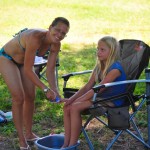
The open sky overhead the expanse of Lake Kariba was majestic: softly shimmering dusk hues changing to grey waves barreled in by the wind.┬Ā Our last night was one of humbled awe in the might of NatureŌĆÖs power. The dry storm brought enormous gusting winds and lightning so intense and vast and prolonged, sheeting across the sky, commanding the retreat of darkness. The tent pegs were uprooted. Marcelo, the brave,
had to re-peg and ŌĆśdrop anchorŌĆÖ of the last remaining stabilizing leg of the trailer as well as park the vehicle so that the we were in the wind-shadow. Then the thunder came rolling in with large drops of pelting rain. ŌĆśWhen I in awesome wonder, consider all the worlds thy hands have made, I see the stars, I hear the rolling thunder, thy power throughout the universe displayed, then sings my soul ŌĆ”ŌĆ”ŌĆÖ
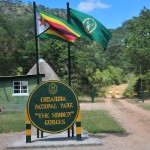 Chizarira National Park, Zimbabwe – Celeste
Chizarira National Park, Zimbabwe – Celeste
From ***** five star luxury to camping took a bit of adjusting. We did not stock up
on groceries at JayŌĆÖs Spar at Vic Falls, rather heading out to Hwange to the Spar there.
They unfortunately had very little stock. Lesson: In Africa stock up on items when
you see them. Little did we know that that was only the first challenge fo the day. We
travelled south east on the A8 as far as Gwayi River (no fuel ŌĆō second challenge) then
turned north east to Lubimbi. According to our ŌĆ£Ultimate Africa AtlasŌĆØ the only
entrance to Chizarira was in the South of the Park. Wrong. The lady on the dashboard
did not even know of the ParkŌĆÖs existence, until we were already there ŌĆō then she
indicated a few of the tracks ŌĆō too little, too late.
But, after all, we are on an adventure, and so it was! We stopped frequently to ask the locals for directions, each one different from the one before. We met people waiting for the bus, shop owners and even a Catholic priest. He was young, strong and shining with energy. Originally from Spain, he was posted at Dandanda Mission 4 years ago. With the little brick church, it was certainly the neatest hamlet along that stretch. He was racing along in a white bakkie, giving some people a lift. Well, not only was it incomplete, our map was incorrect.
ŌĆ£The road goes like this to Lisulu,ŌĆØ he said, drawing it in for us, saving the lost. ŌĆ£There you ask for Benjamin at the store where they grind mielies and they might have some diesel too.ŌĆØ 20l cost us more than usual but we paid gratefully after several hours of through rough, rural Zimbabwe.
Finding a sign to JedsonŌĆÖs Camp we followed it, knowing it was an isolated spot on the border of the Park from a magazine article dated 2004. The darkness overtook us but we pressed on a bit further. ŌĆ£Shall we camp here in this spot between cows and mielies?ŌĆØ ŌĆō no, just a bit further. Dense bush enveloped us and it was as if we were tunnelling through a thick greenness to an ŌĆśotherworldŌĆÖ- which I guess we were.
We finally stopped after losing one of the back stabilising ŌĆślegsŌĆÖ of the trailer, and just as well, for on the morning we found ourselves atop a narrow mountain strip with gorgeous gorges on all three sides. All impressions change at night ŌĆō the grass is taller, the roads rougher and the distances seem further. That night in the car was not our best, but neither was it the worst ŌĆō jot it down to experience.
Baboons hackled each other, echoing with the MeyerŌĆÖs parrots at sunrise over the beautiful bush. After winding along further overgrown paths, we found one that looked recently travelled, not oft travelled, mind you, but just with shorter grass. ŌĆ£Yes, this is JedsonŌĆÖs. No, it is no longer running,ŌĆØ said the six guys we found in a bushcamp. We went a bit further round the sandstone ridge and found remnants of what must have once been an amazing camp: pool, braai area, tents under thatch, kitchen, loos with views overlooking the entire valley of thick Brachystegia msasa (Mountain acacia).
Jabulani offered to escort us back to a tract that would supposedly lead us straight to Chizarira (have we heard that before?). Danica perched on my lap while he sat in the back. He helped us rebuild areas of the road and finally reached that magical point of ŌĆ£the way.ŌĆØ Previously owned and run by ŌĆśMr. JedsonŌĆÖ, as a photographic camp, now owned by Neil for the past 18 months as a hunting camp. ŌĆ£Yes, yes, there are too many poachers. Last night we saw your lights and were afraid because they come armed.ŌĆØ Like a sadly dejected child, he told of how they were poorly paid without adequate food rations. The consequences of no guests were far-reaching. He received the food, drink and money humbly. One can remember when the Zimbabweans used to be nick-named ŌĆśwhen weŌĆÖs ŌĆ”ŌĆÖ.
A long, straight track of an old, unused fire-break with many overturned trees lay ahead.
Then we descended through rocky ridges of the Busi Escarpment, seeing the Chizarira Basin ahead. We arrived, finally, into the Park from the back end where we came across a freshly painted sign ŌĆō a good sign. Yes, and no. That was all that was fresh about the upkeep of the Park.┬Ā We immediately turned left to check out the Mobola platform camp, a slightly built-up flattened area overlooking a small stream in case we decided to camp here. The bush was cleared but there was no water, or any other facilities, despite an old, thatched bathroom area still standing, dead squirrel and all. ┬Ā
We headed for the headquarters, crossing over the airfield where we saw a small herd of Common Waterbuck. The last visitor was a single German who stayed one night last month. Gopito helped us in the office where there were a few old and dusty skulls, trees and grasses displayed. We had a choice of a site overlooking the gorge or one down by the river, but no facilities. ŌĆ£Yes, there are many poachers here, but there were even more in
December.ŌĆØ Even their own water pump had broken seven months ago. Pay and smile or go home. The adults voted up high, the kids voted down low, so, being democratic, we decided to view each before deciding. Of course, time ran out on us and we only got to the river camp, Kaswiswi No. 2. There were two wooden stilted shelters and a lapa, and a run-down bathroom which must have once been great. We stayed two nights. Nicolai found 4 tiny mice, which Danica adopted and fed on three-hourly shifts day and night.
Discussions about Mother Nature and survival of the fittest and the poor likelihood of them making it, did not deter her. Her intense love of animals never ceases to amaze me ŌĆō such passion in one so young!
The sites overlooking the gorge were spectacular, overlooking the Mucheni River, a thin green snake far below. We munched apples and biscuits under a cliff-clinging tree, the Albizia tanganyicensis (Paperbark false-thorn) with beautiful smooth, creamy bark, peeling off in reddish, papery pieces tickled by Foxtail Buffalo Grass (Cenchrus Ciliaris) grass. A pair of Verreaux Eagles looked positively minute flying the currents in the massive space of the Sinamagoga Gorge.
Washing and swimming in the river was slippery fun amongst the dragonflies and butterflies. The dishes were cleaned in the same way. Hippo and elephant swathes through the long grass were aplenty with fresh hippo dung. Baboons called in the early mornings and Spotted Hyenas called nightly, along with Scops and Barn and Wood Owls. Even earlier in the mornings brought the Ground Hornbills boom-hooting as well as the Verreaux Eagle Owls.
We made the spot our home, doing school work, playing soccer (Nicolai and Marcelo both playing passionately!), feasting on chicken mayonnaise sandwiches. Not only our home, but we shared it with a slim, Green Water Snake (Philothamnus hoplogaster) under an African resin tree (Ozoroa insignis). Short, black spikes somehow found there way into NicolaiŌĆÖs finger. Picked out individually and creamed, the itchiness and pain got worse before it got better. Only when packing up the tent did we find the culprit ŌĆō a ŌĆśthingŌĆÖ of unidentifiable nature (insectish) covered with a cocoon of, you guessed it ŌĆō short, black spikes.
I had to scout ahead frequently through the tall grasses, taller than the car plus roof-rack contents, sometimes making a way where there wasnŌĆÖt. The absolute highlight of Chizarira was a secret kept until the last drive out for us ŌĆō exactly the opposite side from which we had entered, 180 degrees from the actual entrance ŌĆō accessed from the Binga – Karoi┬Ā┬Ā┬Ā road. Winding down from the escarpment into the valley below was a mountainous track through stunning vegetation and rivulets, twisted and intermingled ŌĆō Tolkien at his best. It would not have surprised me in the least to have seen some faeries too ŌĆ”.
Victoria Falls ŌĆō text & pictures by Danica de Freitas (9)
Nicolai got very excited when Dad told us that we were going to stay in a hotel, but I was mostly excited for the Falls themselves.┬Ā The old-fashioned Victoria Falls Hotel was huge and held lots of memories for Mom and Dad as they had stayed here on their honeymoon 20 years ago.┬Ā It had 3 restaurants, a magnificent view over the bridge and an enormous pool.┬Ā Nicolai was delighted to find a TV in the room with Disney channel.┬Ā We had supper and watched tribal dancing at Jungle Junction.
I caught the bridge at the right moment in a photo with the mist rising in the morning light on the way to breakfast.┬Ā I helped myself to muesli and strawberry yoghurt, while Nicolai enjoyed the bacon.┬Ā On the pathway leading to the Falls, vendors crowded around Dad offering him wooden masks and old Zimbabwean dollars, which we didnŌĆÖt want to buy.┬Ā A few were even renting raincoats, which made us wonder how wet we were actually going to get.┬Ā Arriving at the gate and seeing people walk out dripping, was enough to persuade Dad to go and fetch a plastic bag for his camera.┬Ā Anyway, he had to get the passports to prove our citizenship in order for us to qualify for the SADC rate.┬Ā We waited , playing with some pieces of fallen thatch and we sang ŌĆ£ if youŌĆÖre happy and you know it stamp your footŌĆØ.
We followed a stony pathway into a rain forest created by the spray looking forLivingstoneŌĆÖs Turaco.┬Ā We rounded a corner and saw DevilŌĆÖs Cataract pounding past, down, down into the gorge, with a rainbow overhead.┬Ā
It was louder than I expected and musch longer too.┬Ā It really does live up to itŌĆÖs name Mosi-oa-Tunya (the smoke that thunders) before Livingstone discovered it.┬Ā Nicolai posed like his statue, which just came into sight.
Mom and Dad hid their cameras under their shirts which hardly helped but I didnŌĆÖt have to worry, mine is waterproof.┬Ā Nicolai and I enjoyed the spray, ridding us of the heat as the main falls appeared before us.┬Ā It sent a shiver down my spine.┬Ā We were spat rudly in the face, enjoying every moment it lasted.
We had chocolate cake at the restaurant to celebrate, then looked at the information boards, describing the formation of the falls and the early people living there.┬Ā We walked back the long way to avoid the vendors, but it was very hot.┬Ā We all had a nice cool shower when we got back, then went into town to look around.┬Ā When we got to Livingstone Toyota, I did
something rather stupid.┬Ā I slammed my pinky on my right hand in the car door.┬Ā I watched in horror as it slowly turned purple and blood dripped out on one side.┬Ā It was terribly sore, but nothing that a swim in the cool pool could not fix.
Night came and we had supper at the Kingdom Hotel, just down the road from ours ŌĆō in the Spur.┬Ā Breakfast the following morning I think was the best that we had at the Victoria Falls Hotel.┬Ā The wind was just strong enough to bring the spray from the falls onto us, in a light drizzle.┬Ā I looked up at the sky to make sure it wasnŌĆÖt rain.┬Ā That afternoon we went on a boat ride on the mighty Zambezi.┬Ā We saw Jacanas, Egyptian Geese, White-faced Duck, Darters, Egrets, 5 White-headed Vultures, Fish Eagle, a Giant Kingfisher, an Elephant snorkeling, Hippos grunting and the sunset.
That night we did what we had promised ourselves to do on the first evening we arrived here, go frogging.┬Ā The inside courtyard of the hotel is the perfect habitat for frogs, with three lily ponds and open lawns.┬Ā You could hear the frogs calling every night from
almost anywhere in the hotel.┬Ā To our amazement, the first thing we saw was not a frog, but a huge fishing spider, dangling from a lily flower bud, holding itŌĆÖs catch for the night, a 4cm fish.┬Ā ŌĆ£I didnŌĆÖt know there were fish in these pondsŌĆØ I exclaimed.┬Ā We shone the Energizer beam onto other lily pads where we found a tawny male frog with black spots trying to dislodge a challenger from his calling site.┬Ā On another, we found a half-frog who had grown his forelegs, but hadnŌĆÖt yet lost his tadpole tail.
 The huge, thundering falls and the tiny Painted Reed Frog (Hyperolius marmoratus rhodesianus) only found in this isolated region, will remain in my memory forever.
The huge, thundering falls and the tiny Painted Reed Frog (Hyperolius marmoratus rhodesianus) only found in this isolated region, will remain in my memory forever.
Leaving Botswana talking Rhinos
In Kasane I met Mark Marx. In fact I was getting some supplies at Kasane Spar when he approached me, having seen the RRP (Rhino Rescue Project) and C2C signs on the car.┬Ā He is an honorary ranger of the Chobe National Park and as volunteers they go about looking after natural resources in the area.┬Ā I mentioned that we would be in Chobe for a few days and that if he would like to arrange a forum, I would be happy to chat to them about the RRP. ┬ĀImpressively Mark arranged a forum of 8 including the head of anti-poaching in Chobe, regional vet and others for our discussion.┬Ā We met in the conference area at the Biodiversity Centre.
Chobe has relocated their rhino to a place where they are placed under guard 24/7, as the threat by poaching is too severe. ┬ĀUpper Chobe River system has a public tar road that runs over 100km to the south of the park. ┬ĀAs we know, this is a serious threat to wildlife security.┬Ā It is a huge pity, as this area is incredibly fertile and really calls out for rhino roaming free.┬Ā The Chobe River is well supported by tourists and would be further so with the completion of the big 5.
The discussion lasted almost two hours, and was concluded with a discussion with the regional head of research of conservation in the area that fortunately was able to meet at short notice.┬Ā The RRP was well received and the point was made that the Prime Minister had identified rhino conservation as a priority in Botswana.┬Ā This would be something she was very excited to endorse for government approval.┬Ā A positive morning of discussion left us all filled with expectation that the RRP could be adopted as policy by Botswana Wildlife.
Hwange National Park┬Ā
Stop, close your eyes.┬Ā Reach out, feel for magic.┬Ā What is out thereŌĆ”?
Trees, tall ones, wise ones.┬Ā They have seen so much, so many stories to tell.┬Ā But now they are sad.┬Ā Another season has passed.┬Ā There has been little growth, little change.┬Ā Has there been enough nourishment and growth to get through another period of cold, stagnation.┬Ā Animals too are battling to hold on.┬Ā They run, almost blindly at times, in constant fear.┬Ā The energies are upset, upside down.
Perhaps I was young and na├»ve when I first visited Zimbabwe.┬Ā
I was full of young love, and the world was opening itself to me, for the first time.┬Ā Oh I long for those days for you Zimbabwe.┬Ā The regime was 20 years younger then.┬Ā There were positive feelings and emotions around then, optimism.┬Ā Where are they now?
We drove through the Matetsi area coming from Kazangulu to get to RobinŌĆÖs camp.┬Ā The trees in the area are unique, and we were chuffed to getting into sharpening our tree identification.┬Ā This area is mainly a safari area, where pre-arranged animals are hunted through head office at Harare.┬Ā This was clearly evident as the animals were on edge and ran off quickly.
H.G. Robins, upon his death, donated his farm of 25 000 acres to the then Southern Rhodesian Government.┬Ā We were the only visitors at Robins in the last week.┬Ā Previously they had been visited by a couple from the Cape that had stayed for one night.┬Ā They were desperate for visitors, and I felt for the lady at reception that was stationed from 06h00 to 18h00 daily, in the hope of a visitor.┬Ā The camp is very run down, but the friendly staff make up for it.┬Ā There is a display housed at RobinŌĆÖs look-out tower, which is a tribute to Herbert George Robins (1867-1939). He was a fellow of more than a dozen societies, and being an eccentric chap, one would imagine him frowning at the goings-on, hands on hips and a sad shake of the head.
Robins has the highest density of lions in the park, and one can hear them from late afternoon to early morning.┬Ā After staying two nights we drove 130km through Sinamatella, which is set on a picturesque ridge overlooking an attractive waterhole.┬Ā This area is predominantly Mopani woodland. ┬ĀMain Camp, according to recent articles, had been done up and is 130km from Robins on a mostly good road.┬Ā As the name suggests, this is the busiest of the Hwange camps, and with the open woodland, is the easiest place to see wildlife.┬Ā
The restaurant at Main camp is called the WaterbuckŌĆÖs Head. ┬ĀThe meal was nourishing, it took itŌĆÖs time, and the portions were large.┬Ā We had opted to change the routine and have a meal cooked by another, as opposed to ourselves.┬Ā We succeeded in this.┬Ā The staff of the restaurant had left the chip fryer on overnight, and even though it was now 24 hours later, and we were sitting in an open air dining room, the stench was nauseating.┬Ā It was everywhere from the air to the napkins.┬Ā In fact there was a table of four English guests next to us that lasted about 30 minutes.┬Ā With their food taking its time to arrive, they stood up and left, hungry.
On the way out from dinner I was greeted by the table next door.┬Ā There was a large figure, a local by the name of Bongani.┬Ā His fingers were shiny with oil; he had rolled together some maize, and was dipping this African ŌĆśdumplingŌĆÖ into his sesheba.
ŌĆ£I see that you have some rhino stickers on your carŌĆØ he grunted.
┬ĀŌĆ£Yes, IŌĆÖm promoting a new technology in rhino anti-poaching,ŌĆØ I replied.┬Ā ŌĆ£We inject an ectoparasiticide into the horn, and this makes it unsuitable for human consumption,ŌĆØ I added.
┬ĀŌĆ£Well, I am Mr. Rhino in Hwange,ŌĆØ he gloated without a smile. ŌĆ£We should meet.┬Ā Are you leaving tomorrow?ŌĆØ
ŌĆ£No, we can meet. How about 12h00, here at the restaurant?ŌĆØ
ŌĆ£Perfect,ŌĆØ he replied.┬Ā
ŌĆ£See you then,ŌĆØ we agreed.
Bongani had two other folk at the table, and I was walking out with my family, with us having eaten, so the conversation went no further.
┬Ā
The following morning we were up at 05h15, and on our game drive by 06h00.┬Ā There was a fine misty rain falling, which stopped, at times being substituted by a thick dew.┬Ā This Tolkein bloke was following us around with his enchanting mornings but the game eluded us.┬Ā We saw some impala, waterbuck and zebra on the river road.┬Ā We were thrilled to bump into Brent Stapelkamp from the Hwange Lion Research program.┬Ā We had been watching him from a distance.┬Ā We were watching some crowned crane and he politely stopped some way back from us, climbed on top of his Landrover, and waved his antennae around.┬Ā
He could not pick up DSTV.┬Ā Apparently the female he had collared recently was nowhere to be found.┬Ā He had been working in Hwange for 6 years.┬Ā I mentioned that we had been on the road, promoting RRP technology.┬Ā I asked what contact he had had with rhinos in the park.┬Ā Brent mentioned that when he first arrived, he would have 3-4 sightings a day of rhino.┬Ā Now, he had not seen a rhino in 8 months.┬Ā He mentioned that there was rumour of a female and a calf in the area, but he had not seen them.┬Ā
ŌĆ£They are finished in this park ŌĆ”ŌĆØ he commented.
Like a New Zealand prop forward running at full tilt, this comment hit me.┬Ā PhewŌĆ”┬Ā What do you say after that?
We were back at 11h30, where Nicolai made us some bacon and scrambled eggs for breakfast.┬Ā They were delicious, and then off I went to meet with Bongani.┬Ā 12h00, 12h05, 12h12 ŌĆō was he going to show?┬Ā It was a Sunday, although, he had called for the meeting after all.┬Ā With the decline in rhino population evident, Mr Rhino was clearly not succeeding in his efforts to protect the rhino.┬Ā Was there a possibility that he was in on, or aware of the poaching?
I engaged with the waiter and asked if it possible to meet the chef?┬Ā Lazarus (reluctantly at first) approached, wiping his hands saying that he was busy cleaning, although he did manage a smile.┬Ā I mentioned that we had dinner at his place the night before, and that I was appreciative of the logistical challenges with which he was faced.┬Ā
I had a flash ŌĆō RamsayŌĆÖs kitchen nightmares.┬Ā We discussed the difficulties of not knowing how many people would be coming through for dinner, what they would be eating, etc.┬Ā I had witnessed firsthand, the ghostliness that Hwange was going through.┬Ā But this was a first step for them starting over.┬Ā I suggested that instead of providing an a la carte menu, he should consider a set menu, 2 starters, 2 mains and a desert.┬Ā He could then focus on the quality of food as opposed to trying to satisfy everyone with quantity of, mediocre product.┬Ā I got a huge, appreciative Zimbabwean smile.┬Ā There was someone who felt his pain.┬Ā His eyes sparkled, he would be suggesting this to his manager, tomorrow.┬Ā It was almost 13h00, no Mr. Rhino.
That evening, we went out to the Nyamandlovu platform.┬Ā We saw two lionesses asleep on a termite mound, about 100m from the waterhole.┬Ā They were re-charging before the evening escapades.┬Ā We enjoyed drinks as 14 giraffe came down to the water to drink oblivious to any threat.┬Ā There were 2 black-backed jackal, 2 huge crocodiles, 4 hippo, zebra and a lone wildebeest too.┬Ā This was the best game viewing we had the last 4 days in Hwange.┬Ā On our way out the following morning we returned to say goodbye.┬Ā The lionesses had moved about 200m and been joined by an adult male.┬Ā They had not made a kill.┬Ā With herbivores on edge in Hwange, I felt uncertain of the parkŌĆÖs future.┬Ā Was this from poachers, hunters or lions?┬Ā Are friendly staff enough to attract tourists to the park?┬Ā I would recommend you pay her a visit, but rather camp, and bring whatever you need.
At Hwange one gets the feeling that the Marabou Stork is the national bird of Zimbabwe, whereas it should perhaps be the Village Weaver.
Savute, Linyanti, Chobe Riverfront ŌĆō Okavango Swamps, Botswana
┬ĀBy: Celeste
An elephant has just walked past, I mean right past. It is full moon, bright over the Savute River and grass. Marcelo celebrated the time and space we are in with a cigar. ŌĆ£What is aroma, Dad?ŌĆØ asks Nicolai, needing a complete explanation. I was reading to them, sipping my tea. Crunching grass contrasts with quiet footfalls. We first hear the crashing branches and then a huge adult bull is standing there ŌĆō it wouldnŌĆÖt be a small one now would it? Mind you, the young teenagers are sometimes more unpredictable and problematic.
Take for example the one that chased a couple approaching the ablutions this afternoon, with expressive trumpeting and impressive ear-flapping, or the Zambians we met who had a tempestuous elephant spearing their car from behind on a previous visit. Imagine the reaction from their insurance! ŌĆ£Oh, that wasnŌĆÖt all. Afterwards, we got stuck in a river.ŌĆØ DanicaŌĆÖs eyes widened, despite her apparent nonchalance. Willie and his wife were helping Marcelo with the car, which would not start again, together with Carol-Anne and Kurt from Pretoria ŌĆō we had met them all at the Okavango river Lodge camping ground in Maun before entering the Swamps.
┬ĀThe shadow takes full form, wrinkles and all, tusks only a few metres away, sharpened by the moonlight.
It was one of those ŌĆśtime stood stillŌĆÖ moments. He plucks grass, shaking the tufts free of dirt against his knees before stuffing his mouth. Mouthful after mouthful. I will him to wander down to the river. He must be thirsty now. He turns and walks calmly (him, not me) straight towards us. By this time, I am clinging to Marcelo with one hand, the other clasped over my mouth in suspense. He passes between the table and chairs and the tent ŌĆō I can hardly believe an elephant can fit in this gap ŌĆō right at eye level. If he had swung his head ever so slightly, his tusk would have ŌĆ”. could have ŌĆ”. This is the beauty of the Swamps ŌĆō being surrounded by the wild. Lions and more elephant grumblings. Hyena and owls. Nightjars and bats.
┬ĀWe had set up camp, arriving only at 20h20 after a little incident with deep sand requiring a bit of digging, some winching and some tense discussions. Three young guys, electricians at a new lodge, had assisted us, more in spirit than manpower. Their short-wheel base landy was a dinky toy in comparison with the Staffie and trailer. We had been cheerfully overtaking one another intermittently since Maun. Marcelo had obliged by taking their photograph at the entrance to this section of the greater Chobe National Park over the Khwai River. ŌĆ£Oh man, this is a **** up,ŌĆØ they cheerfully greeted us. Later, we parted, equally as cheerful, with some meat and South African beaded flag keyrings as we parted ways. Thank you Alfred, Luxam and Bongani. We are treated to a ratel padding along, white streak shining silver in the moonlight.
┬ĀFrom Xakanaxa we had to travel via South Gate as the River Road to North Gate was flooded, as was the actual river crossing. So we had opted to go the extra mile and re-fill with fuel in Maun before heading northwards once more.
William, the camp manager brings Scar, a roundish, shortish man with magic in his fingers. He took out the starter motor, cleaned it and the solenoid. Nicolai peppers him with questions. ŌĆ£What is your national animal? And fish? And bird?ŌĆØ Zebra, Tiger Fish and Kori Bustard. After various other tinkering we clapped with praise at his skill in getting Staffie on her paws again.
HarveyŌĆÖs PanŌĆÖs held the most game, with wide, open savannah supporting giraffe, zebra, impala, warthog, elephant and huge (400 +) herds of muddied
buffalo. The road around Quarry Hill was stunning but the
San paintings at Bushman Hill were unimpressive. Sticky climbers, poking thorns and blackjacks surrounded the overgrown pathway. Determination notwithstanding, we only ŌĆśdiscoveredŌĆÖ a single painting of zebra and eland. A lifer more than made up for it: a Striped Crake in the flooded grasslands after Rhino Pan, itself inundated with a large flock of Collared and Black-winged Pratincoles.
Danica sketches a fish-eagle perched in the tree opposite in the early morning light. ┬ĀNicolai has the tracking book, his sketchpad and pen in hand. We are off on the hunt. Beetles, birds, elephant ŌĆō 59cm. ŌĆ£But the book says 58cm for a femaleŌĆÖs hind foot,ŌĆØ questions Danica. Males come in at 50cm. Baboon, tree squirrel, mongoose.
┬ĀThe ablution block is built within a high wall that one can walk atop giving a great view of the surroundings. Inside it, it houses mongooses galore.
I am engrossed in the Common Wild Flowers of the Okavango Delta by Veronica Roodt, detailing their identification, traditional uses and legends. A Wild foxglove (Ceratotheca triloba) white with dark mauve stripes on the inner lip, tall stalk with furry leaves ŌĆō itŌĆÖs multi-purpose is astounding ŌĆō anything form abortion, diarrhoea, eye problems, flatulence, nausea and my favourite, earache.
Whilst being earth-bound for the duration of the car maintenance, we achieve the completion of a mathematics capacity water-fun exercise; a discrimination and bias exercise for life orientation ŌĆō thanks to The Telegraph: Journalism with courage. A Chocolate Cake/Brownie reading and comprehension practical for Nicolai took the cake! Separating each biscuit crumb from itŌĆÖs neighbour, melting butter with solar energy, syrup, cocoa powder. Jamie Oliver would have been proud.
We met a lovely Swiss Family, the Herzig-Waldvogels, doing a six-week stint from Kenya to Cape Town. They had travelled in Africa before, Pascale even doing anthropological research. Uli is a conductor and music teacher. Flurin, their ten year old son, Lorena, their eight year old daughter and our two played fly and soccer happily for an hour or two. We invited them for dinner. Marcelo served up two chicken potjies of note. The children played charades, not needing much language at all, but producing much laughter. Wine, chocolate brownies, stars and good company led to a 23h30 bedtime.
Linyanti is remote and we are alone for two nights in our site, perched next to a termite mound, under several Jackalberries, overlooking the lagoon where we watched the jacanas, Black Crakes, kingfishers, elephant, hippos ŌĆ”.. not rubbing it in or anything, but it was amazing. Kudu wandering past, more close encounters of the elephant kind, vervet monkeys, baboons, warthogs, mongooses, butterflies. The roads are minimal and most action takes place right here in camp. Games of lassoing branches follow the kids work. A fish eagle swoops for his dinner at sunset whilst we play cricket.┬Ā Green Pigeons alight in flocks above.
We are awakened with the most powerful racket imaginable: hippos. After fighting for about half-an-hour, the victor ploughs back into his lagoon, the other slinks off through the trees, leaving us wonderfully fresh spoor.
Several army vehicles speed by, backwards and forwards on border patrol and anti-poaching, we guess. Namibia lies across the river.
Travelling towards Kasane, it is 45 degrees. We stop to ŌĆścool offŌĆÖ the car, leaving the bonnet ajar. The fridge is at 15 degrees and the freezer is now a fridge, despite the solar panels working well over the past few days. Energy, power, water, food, safety ŌĆō all daily concerns.
We see four Southern Ground Hornbills in a bare tree en route to Kasane as the main road
traverses the actual Chobe National Park. Kasane is a bustling town, new alongside old, smart contrasting with shabby. Lots of building going on, even timeshare duplexes. No diesel here, go on another 15km to the border. The fully-stocked Spar is fantastic. Marcelo is approached by Mark, an honorary ranger who had seen our Rhino Rescue Project stickers on the car. The longer they chat, the higher the level in the trolley. Marcelo and Nicolai have sneaked in a surprise for me: Trees of the Okavango Delta ŌĆō the Part I I had been longing for (not available anywhere up till now).
┬ĀThe children are horrifyingly dismayed by the one-fingered beggar outside, the rest of his hands all scarred and gnarled. The whyŌĆÖs and howŌĆÖs unanswered, guesses of birth deformity, polio, leprosy ŌĆō all discussed at length. Just yesterday whilst squeezing out the washing, Nicolai and I had chatted about the blessings of hands, the strength and softness of hands, the joy and uses of having two hands!
┬ĀChobe Riverfront is a world apart. We entered at the main gate, booking two nights at Ihaha campsite. Tourists like mushrooms atop their fertile bases abound. A wildlife
paradise ŌĆō a sheer proliferation of elephants, old and young, timid, relaxed or cheekily-aggressive ŌĆō all manner of ages and temperaments ŌĆō everywhere! We take three hours to get to camp, bewildered by the beauty of the Riverfront road only metres from the water: hippos, crocodiles, impalas, giraffe, impala, two lion prides!
┬ĀWe reached camp after easing our way through another herd of buffalo with many young, also overlooking the river. Memories that will last a lifetime: being surrounded by a herd of elephant at night; fish eagles galore. What got to Nicolai the most was that the monkeys actually managed to unzip our tent and munch on soaps and books inside before scooting off when we disturbed them. Can you believe it ŌĆō they even left teeth marks in my book! And Danica finally gets to see her Puku!



